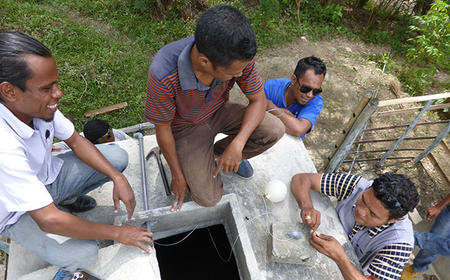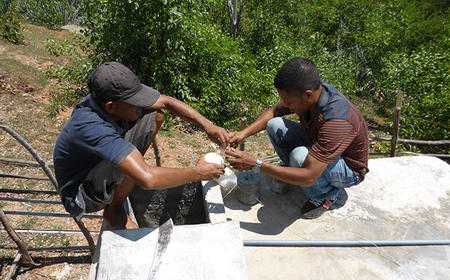Enabling communities to monitor water levels in Timor-Leste
Achievement of universal access to water and sanitation often requires strong community participation. However, some tasks, such as monitoring water levels, can be too difficult to fulfil. In Timor-Leste, WaterAid is working with local people to find a sustainable solution. Moises Pereira, Water Resource Management Officer at WaterAid Timor-Leste, explains.
WaterAid has been working in Likisà district, Timor-Leste, since 2007, and in Manufahi district since 2011. In that time, we have strengthened our implementation approach with local partner NGOs and local government. Our implementation approach aims to support our partners whilst they work with communities to implement new water systems. We include water resource management to ensure that the water supply is more sustainable.
The Government’s Strategic Development Plan 2011–30 aims to ensure everyone in Timor-Leste has access to water, sanitation and hygiene (WASH) facilities by 2030. A national decree stated that operation and maintenance of water and sanitation services in rural areas are the responsibility of the community, where a water supply system falls within the limits of a settlement, a hamlet or a community. This can be difficult for communities to manage.
Adapting to context
At WaterAid Timor-Leste we have developed our approaches to complement this devolvement of responsibility, and adapted methods in response to communities’ experiences. At the start of each water supply project, we work with local partners to facilitate a community action plan and form a community water user group. This group is responsible for continuing the operation and maintenance of the water system and collecting funds from each household.
Challenges arise in many communities during the dry season, when water is in shorter supply. Water user group members have to visit the source every day to open the reservoir tank and check the level of water inside. This takes up precious time, and some people also struggle to move the heavy manhole cover. These barriers often reduce a community’s motivation to participate in monitoring and controlling their system. They need a cheap, simple method, which is easy to implement, understand and maintain.
Trial and error
Efforts to find a solution to this challenge began in 2015 when Kate Neely, a PhD student from Deakin University, implemented a simple water level indicator tool in Lautekas community in Maubara sub-district using local materials. The community was keen to pass on the process to other communities, but the materials used may have posed a long-term risk to the water quality because they included a plastic container filled with soil in order to create a pulley system.
We had a rethink, and tried a different pulley design prototype at the WaterAid Timor-Leste office, but found that the indicator was too sensitive to the weight of the float and anchor. We tried a new simpler design, and piloted it in Taliposa Community. In this design, a float inside the tank was tied to a string that passed out of the top of the tank, and was tied to an external level, enabling people to judge the water level from outside.
After one week we visited the community to ask for feedback. We improved the design according to their feedback, with a stronger line and heavier anchor. We addressed other challenges we found, which included uncertainty amongst some community members regarding the level indicator, children playing with the string, and the need for fencing so as to cover the reservoir tank and make it safe. We encouraged the water user group to explain the indicator to the whole community, and discourage children from playing with it.
A final design to share
The resulting design gives the community an early warning system, and provides information, transparency, and a time-efficient way for water user groups to check the water level in the tank. This means they can react to shortages by restricting the flow of water from the tank, and limiting the hours at which people can access water, helping the supplies to be rationed.
The indicator is a cheap and easy way to help rural communities stay involved, independent, in control, and supplied with water, especially in areas experiencing the effects of El Niño.
A major benefit of the indicator is that it empowers the community, giving them confidence to manage the system. With the water level recorded, the chief of the user group has more confidence to help the community and to support the user group’s regulation of water.
We learned that communities and water user groups are keen to take care of their facilities, and that the process and design benefit from their involvement from the start. In the future, we will also involve our local partners and Government water supply staff.
WaterAid plans to implement the design in other communities which face the same challenges in monitoring and rationing as Taliposa, and to monitor the progress and feedback here on our website.
An Australian aid initiative implemented by WaterAid on behalf of the Australian Government.






